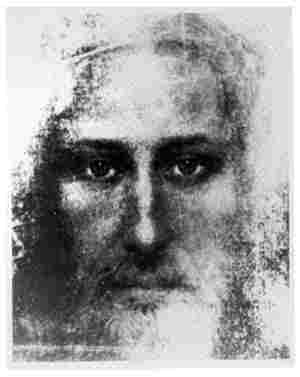The "photos" of Jesus
![]()
In this page, and in this other one, we find several SB's "miracles of materialization", all regarding Jesus: SB would have "materialized" two different "true" images of Jesus, a small christian book with the "true" story of Jesusu, and a tiny crucifix with the "true" representation of Jesus crucified. Now, it appears more and more clear that SB confuses and makes controversial Jesus and his words, and then he replace it with his versions. Why this, at what purpose? Why SB never makes this with Buddha, Muhammad, Rama, Krishna, etc...?
I think it's as follows: regarding Buddhism and Hinduism, SB doesn't need to rearrange anything: he is hindu, and Buddhism is son of Hinduism. Thus over devotees coming from these traditions, SB has already a natural ascendancy: the concepts and the stories that he teaches are the same. Consequently, the figures of Buddha, Rama, Krishna and various hindu saints are never altered. Regarding Islamic religione, instead, the question is more complex: SB has few muslim devotees, since Islam is a strong, compact and cohesive religion, which is practically insensitive to external influences; the hindu concepts proposed by Sai Baba are totally alien to it. Here again, therefore,we'll never see SB touch the figures of Muhammad and muslim sages.
Christianity, instead, seems to be more "plastic" and malleable to external influences; and considering that among european and american people (mostly christians) are the most wealthy SB's devotees, here is that quite here SB, through his self-claimed "divine omniscience", tries to show us that what we know about Jesus is wrong and/or distorted (and this could be true, but it is so for ALL sacred scriptures, included the Indian ones, that SB proposes as true...), and after this he proposes his versions, all form his fantasy, more or less. A christian whi accepts this path, i.e. to "disassemble" Jesus and to "reassemble" him according to SB's visions, he becomes dependant on SB for his own faith; and as a lasting fact, he totally becomes a follower of Sai Baba. Even better if he's a rich follower... Then let's see what Sai Baba proposes to us.
![]()
Another example of how Sai Baba's word is one, clear, unequivocal, and it contributes to make clearness on the questions in which he is concerned, is the question of Jesus "true" story and photos. Regarding these last, the known ones are two, and you can see them below.

This image would have been "created" by Sai Baba during an interview with an english couple. The husband was a devotee of Baba, while the wife was a devoted christian. For her faith, the divinity of Sai Baba was cause of conflicts and also of problem between the consorts.
During the interview, the husband's camera would have begun to click itself repeatedly. The two consorts, once back home, developed the film in an handicraft dark room, without any sophisticated device, and what they found impressed on the film was this image resembling to Jesus.
During their next trip to India, Sai Baba called them again for the interview, and asked them if they appreciated the photo. He said that the photo was of Jesus at age of 28/29, while going back home from the "lost years in India" (see below). Needless to say, the wife after this "miracle", got much closer to Jesus, but most of all became herself a devotee of Baba.
![]()

This other one, instead, was "materialized" in 1985 to B.A., an australian devotee. She, during the darshan (when Sai Baba walks among the devotees to show himself, takes the letters, etc.), gave to SB a crucifix and black-and-white computer image of the Shroud of Turin, for him to bless these objects.
The crucifix was not blessed, but Sai Baba took the paper sheet with the image, and from it "created" a sheet of glossy photographic paper. He passed his hand on the sheet, on which "appeared" a color photo of Jesus which, once subsequently examined, resulted to be coincident with the image of the Sacred Shroud of Turin.
What it would have to appear clearly, now, is the question:
which one would be the "true" photo of Jesus?
The first one, not conventional, or the second one, wiche is linked to the Shroud and resembles the classic christian iconography?
Are we sure that Sai Baba "knows the true image" of Jesus...?
All this doesn't contribute to make clearness on the question, also considering the alleged "true stories" of Jesus spreading around due to the work of Sai Baba. I've heard almost three of these stories, told by Sai Baba himself to the devotees:
The common point to all the stories, anyway, is that Jesus has been in India, where he learned his divine and spiritual knowledges (and since the position of SB on India is as we have seen, how could ever be otherwise?!?!?). The different stories, moreover, have been source of disputes and discordances between devotees, some persuaded that one story was true, some other persuaded that the other story was true... however it's a further demonstration of how contradictory are Sai Baba's words, and of his real "omniscience".
![]()
Click on this link to reach the page related to the bok and the cross materilazed by Sai Baba, or click the "back" button on your browser to go back to the previous page, or go to the initial page.